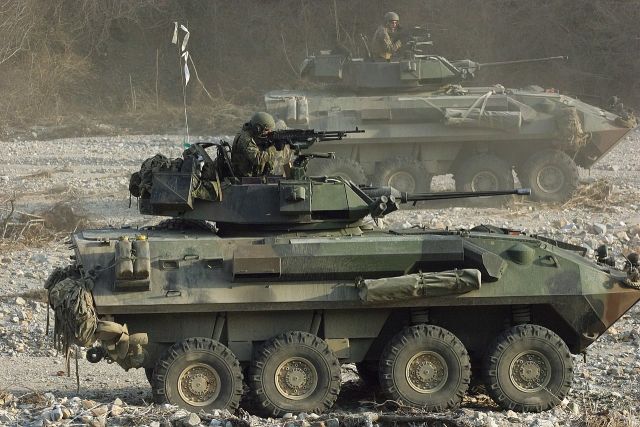
The first photographs of the 8×8 series wheeled armored vehicle LAV-25 are shown. It is equipped with a multi-shot launcher for loitering ammunition, often referred to as 'suicide drones'. It accommodates 8 drones, and they can be of different configurations. The armored vehicle was created for the United States Marine Corps and will allow drones to strike distant targets even with & nbsp; small units.
In 2021, the Israeli company UVision was awarded a contract for the supply of a powerful Hero-120 kamikaze drone and multiple charge launchers (MPUs) of such drones for the US Marine Corps.
The Marines chose the Hero-120 variant for their armored vehicle. However, UVision indicates that the facility, where it will be possible to charge eight drones simultaneously, is capable of launching any version of loitering ammunition, as well as other representatives of the Hero series – Hero-30 and Hero-400 EC. All that 'death row' & nbsp; are launched from preloaded launch containers. This makes it easier to load the selected ammo types or reload the entire launcher.
American Organic Precision Fire Mounted & rsquo; (OPF-M) based on the hull of the LAV-25 with the Hero-120 loitering ammo launcher, to some extent it plays the role of GMLRS. pic.twitter.com/fzEDnsaJYA
& mdash; Caesar (@ Ninja998998) October 10, 2021
Hero-30 is suitable for precise attacks on small targets, Hero-120 is suitable for medium and armored targets, Hero-400 is for long range targets and maximum hardened targets.
Hero-30 has around 30 minutes of battery life and a warhead weighing just over 1 pound. The Hero-120 has a warhead weighing just under 10 pounds and a maximum range of just under 25 miles, and can stay aloft for up to 60 minutes.
The larger Hero-400EC has a warhead of almost 90 pounds and 120 minutes of flight time. UVision says the Hero-400EC can be tuned to extend its range up to 150 km.
All three types of stray ammunition have conventional and infrared video cameras that allow the operator to observe what the ammunition “sees” throughout the flight. It is the presence of the camera that separates the Hero from other types of such missiles. This allows them to function as reconnaissance drones and then transform into attack combat vehicles. & Nbsp;
The Hero Series on-board navigation systems allow them to be used to strike fixed targets at specific coordinates, as well as beyond the limits of the operator line of sight.
The Marine Corps believes that loitering ammunition is necessary to implement a new concept of warfare. This concept is based on how the Marines plan to fight in the future, including in conflicts with nearly equal opponents, like Russia or China.
Weapons such as the Hero-120 provide a way for relatively small land-based marine units to perform high-precision strikes over long distances, as well as expand their overall awareness of what's going on around them. of them. This gives units such an opportunity in the absence of the ability to deliver traditional air or artillery strikes. This can be important in operations on a large front, such as in the Indo-Pacific, where other types of indirect fire support may not be available.
The Marines are also planning to install kamikaze drone launchers on small unmanned boats, which will be able to inflict massive attacks on enemy ships. Although drones cannot sink ships, they can damage critical systems such as radars or communications antennas. This, in turn, could effectively deactivate these ships for an extended period.
Source – & nbsp; https://www.thedrive.com

